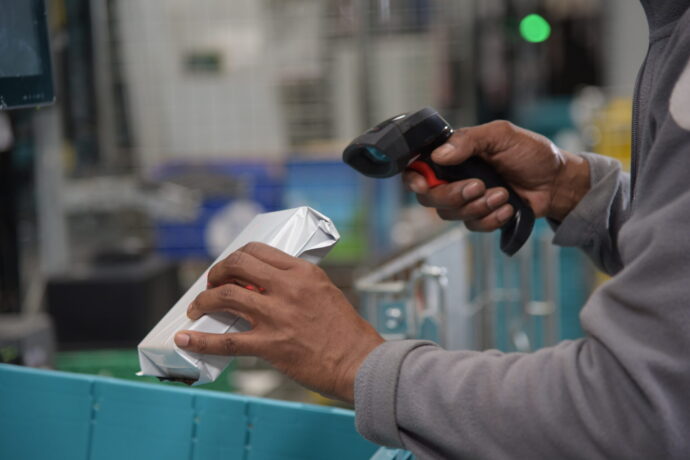
Despite the current relative recession, the fashion and clothing market is still one of the most dynamic in the world, with some very specific ways of organising and developing its supply chain, particularly in intralogistics. Between (fashion) effects and more lasting trends, we begin by deciphering the specific features and challenges of the clothing sector, and their impact on the sector’s warehouses.
(A short) history of the clothing supply chain
To fully understand recent developments in the clothing supply chain, let’s start by recalling some of the key stages in its structuring – which is, after all, fairly recent – over the course of modern history:
- In the 19th century, industrialisation gave rise to mass textile production, changing the skills of workers and their working conditions, with the transition from manual production to the first forms of automation, which found the textile industry an ideal testing ground.
- Globalisation then gradually emerges, with textile supply chains beginning to become more global and complex, and a new division of labour that will last a long time between suppliers of materials, manufacturers of finished products and retailers at the end of the chain.
- Alongside the emergence of haute couture, the 20th century brought social rights, mass production and the rise of synthetic materials, all of which have had an impact on the fashion and clothing industry, sometimes with negative effects on the environment…
- Finally, in the last quarter of the last century, a double revolution took place, with the arrival of fast fashion on the one hand and e-commerce on the other. This changed – or almost changed – the way fashion was consumed and distributed.
Fast-fashion
Low prices, stylish clothes that go from design to production to sale in a very short space of time: the fast-fashion concept, which has been around for a long time, first appeared in the 1970s. Zara, HM, Uniqlo and Gap are just some of the brands that are emblematic of this trend, which has radically changed not only the way clothing is consumed, but also its supply chain. With collections changing dozens of times a year (every fortnight for Zara), in a push logic taken to extremes (see below), these players naturally have to design supply and distribution models capable of meeting these speed ambitions.
Fashion now largely connected
With the current huge successes of online clothing giants, mainly Asian, such as JD, Shein, Amazon, Coupang and VIP, e-commerce in the clothing sector is – as ever – enjoying record revenues and growth. Whereas in 2020, e-commerce orders for clothing accounted for just 30% of purchases, experts estimate that this figure will rise to over 40% by 2025.

Where does fashion stand now?
Clothing consumption has exploded over the last 20 years. Fashion consumers buy more than 80 billion new items of clothing every year, an increase of more than 400% on what we consumed just two decades ago.
Overall, however, after years of continuous growth, confirmed despite the COVID from the beginning of 2020 to mid-2022, the clothing market has been experiencing a certain recession since 2022, and is unlikely to see any real upturn between now and the end of 2023. Even if there are some notable exceptions in terms of sectors (sports or luxury) or geographical zones (Asia and North America), the clothing market as a whole is less dynamic than in the past, in terms of overall revenues. The main reason for this is widespread inflation, which is pushing up the price of raw materials as well as finished products, and causing consumers to postpone their purchases, favouring more essential products in these lean times rather than those designed to fill their wardrobes.
No more seasons?
One of the major determinants of today’s clothing supply chain is also the seasonality of orders, which is becoming increasingly fluid and unpredictable. In the past, fashion trends followed clearly defined seasonal cycles, structured around changes in the weather and sales periods. But that was before the advent of fast-fashion and its many inter-seasonal collections. What’s more, in today’s digitalised world, new trends can appear and disappear in just a few weeks, with the virality of social networks greatly accentuating this phenomenon. This increasingly rapid and unpredictable seasonality means that fashion and clothing operators have to constantly adjust their stock and supply chain strategy to respond to variations in demand, and to their own strategies. This article looks in more detail at the subject of seasonality as applied to clothing logistics.
Personalisation and diversity of products and channels
Clothing consumers are increasingly demanding personalised or even unique products, as well as ultra-diversified delivery and returns methods. For the apparel supply chain, this means having to manage a more diversified range of products, and a much higher turnover of products than in the past, making the manufacturing, stock management and order preparation processes much more complex. All the more so in an environment that is now largely omnichannel.

An apology for speed
Driven by e-commerce and supported by the giants of the sector who are following the trend and even creating new standards in this area, consumer impatience is imposing an increasingly frantic pace on companies in the sector. And this can be felt in the warehouses, which are struggling to keep up, penalised by a workforce that is permanently unavailable.
And it’s back
While, overall, people are buying – much – more clothing than ever before, the rate of returns is also rising dramatically. While the average returns rate for all e-commerce sectors is 20%, it is now 25% for e-commerce sales of clothing items. This means that companies, particularly those that manage returns in warehouses – and not in shops – need to adopt a dynamic and agile reverse logistics management policy, in order to process returns and rapidly replenish inventory for future sales, while limiting the loss of value associated with these operations.
Sustainability and ethics
Consumers are increasingly concerned about the environmental and social impact of their purchasing behaviour, particularly when it comes to fashion. Beyond the product itself, operators therefore need to manage their operations in a more sustainable way, which may require changes in packaging materials, transport methods and waste management practices, as well as product traceability.
Apparel supply chain strategy: a question of style
There is no single supply chain model for the fashion and apparel industry, to meet the many challenges and rapid changes involved. This is because the market is made up of a multitude of sub-categories, product families and business models that respond to very different constraints and objectives. Here is a simplified classification.
On the one hand, standard mass-produced items, distributed via non-complex routes, are more suited to a supply chain model that favours efficiency, and is rather fixed in nature, with little variation or change in structure over time. This first type of supply chain will aim to optimise productivity and expenditure. Here, production is massive, stocks are high, and consumers are supplied continuously, in a ‘push’ logic, where operators do their best to anticipate their demands and behaviour.
At the other end of the spectrum, we find apparel operators and brands that focus more on innovation and ultra-personalisation – in products, in the act of buying, but also in the multiple distribution and returns channels they offer. This second large family follows supply chain models aimed primarily at flexibility. The challenge here is to respond to the uncertainty associated with the rapid and unpredictable changes in consumer demand, and the resulting regular renewal of collections. Conversely, the number of items per reference is lower here, and the supply chain strategy is described as ‘pull’, because it is the consumers who determine the design – necessarily evolving – of their supply chain strategy.

Balancing efficiency and flexibility
This classification is obviously very schematic, and the truth for fashion and clothing operators lies somewhere in between. Ultimately, they need to synthesise their various ‘customer – product – process’ determinants, in order to design a supply chain strategy that is often of the mixed ‘push-pull’ type, ensuring a well-balanced mix of efficiency (push) and flexibility (pull) in line with their business model, and which will enable them to generate maximum added value.
In conclusion, faced with the recent recession, the rapid seasonality of trends, the increasing customisation of products, the pressure for speed and sustainability, operators are having to juggle performance and flexibility to meet consumer expectations and the constant changes in the market, requiring them to constantly innovate, as we discuss in this article. As environmental and social awareness grows, the search for sustainable and ethical solutions is also becoming essential. Ultimately, supply chain strategy in the textile sector is a subtle balance between different market imperatives, aiming to maximise added value while retaining a healthy dose of adaptability in a constantly changing environment.
Solutions tailored to the clothing industry
Exotec® designs, produces and maintains robotic solutions for warehouses worldwide. In particular for the ready-to-wear and footwear sectors, which account for almost 50% of our projects. Our Skypod® system is particularly well-suited to the challenges of clothing warehouses, offering the performance, responsiveness and flexibility that intralogistics operators in this sector need.
Featured In
Share
News
-
February 27,2025Colruyt‘s Collect&Go continues its automation journey with Exotec
-
February 6,2025Exotec Launches Next Generation of Skypod System, an All-in-One Robot-Based AS/RS, that Addresses the Majority of Processes Within a Warehouse
-
January 9,2025Exotec appoints new Project Operation Director to drive growth in Benelux
Events
-
May 19,2025 | BarcelonaGartner, the reference for logistics trade fairs in Europe
-
June 12,2025 | LondonRetail Gazette Efficiency Debate, in London
Ready to transform your warehouse?
Let us show you how we can take your order preparation to the next level.

